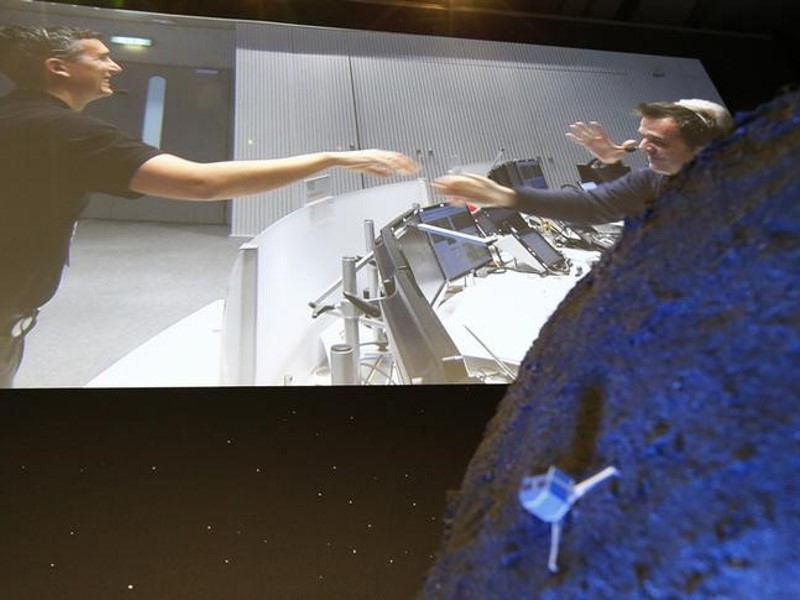- Home
- Science
- Science News
- Scientists Bid Comet Lander Philae Farewell After Radio Silence
Scientists Bid Comet Lander Philae Farewell After Radio Silence

The German Aerospace Center (DLR) said on Friday it suspects Philae is now covered in dust and too cold to operate.
"Unfortunately, the probability of Philae re-establishing contact with our team at the DLR Lander Control Center is almost zero, and we will no longer be sending any commands," Stephan Ulamec, Philae Project Manager of the DLR, said in a statement.
Philae came to rest on a comet in November 2014 in what was considered a remarkable feat of precision space travel. But it closed down soon after because it was in the shade and could not be recharged.
The probe woke up in June as the comet approached the sun, giving scientists hope that the lander could complete some experiments that it had not done before its solar-powered batteries ran out.
But the lander has not made contact with its Rosetta orbiter since July 9, and a last-ditch attempt to re-establish contact with the robotic lab has failed.
"It would be very surprising if we received a signal now," Ulamec said.
While the project team believes that Philae is likely ice-free, the solar panels that recharge its batteries are probably covered with dust.
In addition, night-time temperatures can now fall below 180 degrees Celsius below zero (-292 degree F) as comet 67P/ Churyumov-Gerasimenko moves away from the sun, which is much colder than Philae was designed to withstand.
While Philae did not have as much time as initially hoped after landing for experiments, information it has collected is reshaping thinking about comets, and it has been a useful lesson for designing future missions.
Scientists expect to get a final glimpse of the lander in the European summer, when the Rosetta spacecraft snaps some pictures during close fly-bys, before landing on the comet itself when its mission ends in September.
And in around six years, Philae and Rosetta will near the Earth again when the comet returns to circle the sun again.
Rosetta is a mission of the European Space Agency, with contributions from its member states and US space agency Nasa. The Philae lander was provided by a consortium headed by the DLR.
© Thomson Reuters 2016
Catch the latest from the Consumer Electronics Show on Gadgets 360, at our CES 2026 hub.
Related Stories
- Samsung Galaxy Unpacked 2025
- ChatGPT
- Redmi Note 14 Pro+
- iPhone 16
- Apple Vision Pro
- Oneplus 12
- OnePlus Nord CE 3 Lite 5G
- iPhone 13
- Xiaomi 14 Pro
- Oppo Find N3
- Tecno Spark Go (2023)
- Realme V30
- Best Phones Under 25000
- Samsung Galaxy S24 Series
- Cryptocurrency
- iQoo 12
- Samsung Galaxy S24 Ultra
- Giottus
- Samsung Galaxy Z Flip 5
- Apple 'Scary Fast'
- Housefull 5
- GoPro Hero 12 Black Review
- Invincible Season 2
- JioGlass
- HD Ready TV
- Laptop Under 50000
- Smartwatch Under 10000
- Latest Mobile Phones
- Compare Phones
- OPPO A6 Pro 5G
- OPPO A6s
- OPPO Reno 15 Pro Max
- Honor Win RT
- Honor Win
- Xiaomi 17 Ultra Leica Edition
- Xiaomi 17 Ultra
- Huawei Nova 15
- Asus ProArt P16
- MacBook Pro 14-inch (M5, 2025)
- OPPO Pad Air 5
- Huawei MatePad 11.5 (2026)
- Xiaomi Watch 5
- Huawei Watch 10th Anniversary Edition
- Acerpure Nitro Z Series 100-inch QLED TV
- Samsung 43 Inch LED Ultra HD (4K) Smart TV (UA43UE81AFULXL)
- Asus ROG Ally
- Nintendo Switch Lite
- Haier 1.6 Ton 5 Star Inverter Split AC (HSU19G-MZAID5BN-INV)
- Haier 1.6 Ton 5 Star Inverter Split AC (HSU19G-MZAIM5BN-INV)

















